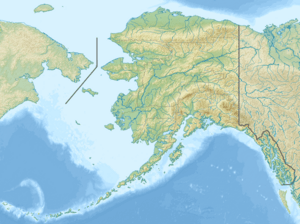Old Crow River facts for kids
Quick facts for kids Old Crow River |
|
|---|---|
|
Location of the mouth of the Old Crow River in Yukon
|
|
| Countries |
|
| Territories/States | |
| Physical characteristics | |
| Main source | Davidson Mountains, Alaska, United States 837 m (2,746 ft) 68°14′36″N 141°36′51″W / 68.24333°N 141.61417°W |
| River mouth | Porcupine River Porcupine Plateau, Yukon, Canada 255 m (837 ft) 67°34′30″N 139°50′00″W / 67.57500°N 139.83333°W |
| Length | 282 km (175 mi) |
The Old Crow River is a cool river that flows for about 282 kilometers (175 miles). It starts in Alaska, which is a state in the United States, and then flows southeast into Yukon, a territory in Canada. This river eventually joins the Porcupine River. The Porcupine River is a branch of the Yukon River, and its water finally reaches the Bering Sea.
Contents
Uncovering Ancient Secrets Along the Old Crow River
The Old Crow River area is famous for some very old discoveries. Scientists have found bones there that tell us about life a long, long time ago. These finds have led to interesting debates among researchers.
Early Human Evidence: The Morlan Study
In the 1970s, a scientist named Richard E. Morlan from the Canadian Museum of History studied some bones found near the Old Crow River. He noticed special marks on these bones. Morlan believed these marks were made by humans before the bones turned into fossils.
If Morlan was right, it would mean that humans lived in Canada much earlier than many scientists thought. This period, called the late Pleistocene epoch, was a time when huge ice sheets covered parts of the Earth. Morlan's findings suggested that people might have been in the Americas at that very early time.
Challenging the Findings: The Thorson and Guthrie Research
Later, two other scientists, R.M. Thorson and R.D. Guthrie, looked into Morlan's research. They thought that the marks on the bones might not have been made by humans at all. Instead, they suggested that natural river actions could have caused the markings. For example, ice moving in the river could have scraped or broken the bones in a way that looked like human tools.
The Ongoing Debate
Richard Morlan, however, did not fully agree with Thorson and Guthrie's ideas. He believed that their experiments did not completely explain all the altered bones found in the Old Crow Basin. The debate continues, making the Old Crow River an important place for understanding early human history in North America.


